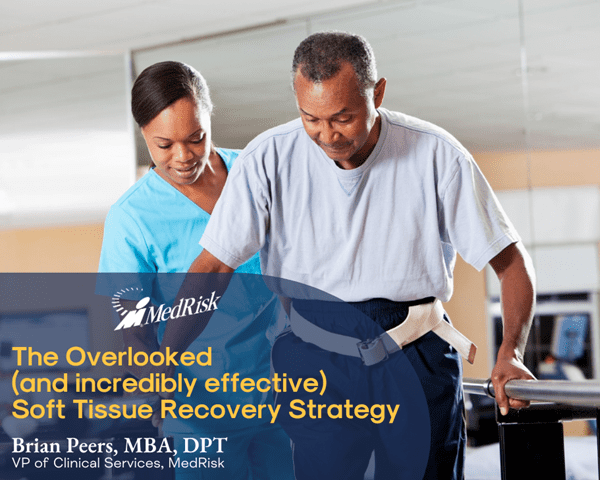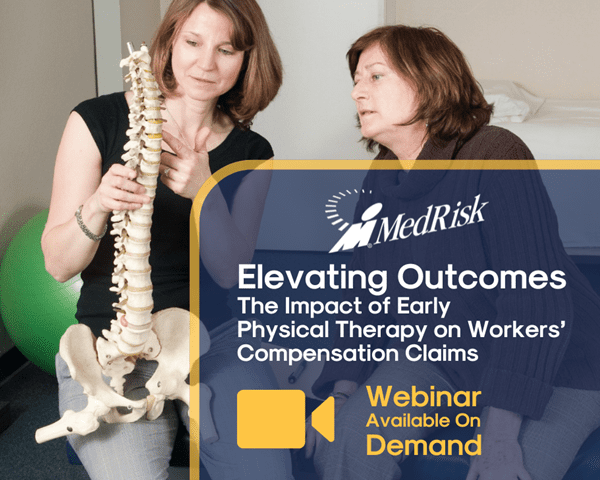
Nov 6, 2024 | Insights
Workers’ comp is changing, and with it comes a fresh perspective on injured workers. We have the opportunity to dive deeper into more of the real challenges and needs of employees on the road to recovery. This isn’t just a shift in perspective—it’s a chance to transform how we approach injury, treatment and long-term support.
We can obtain a broader, more insightful view of an injured worker’s recovery journey that goes beyond the injury itself. Social factors, mental health and economic pressures are increasingly shaping outcomes, impacting every step of recovery. With today’s data, we can even trace patterns in past treatments to anticipate future care needs or potential complications.
This holistic approach is opening new doors in our industry, and every new factor that data can reveal counts in helping employees heal and thrive.
Social Barriers to Effective Treatment.
Understanding factors like race and economic stability is becoming crucial to treating injured workers.
The Study: Recent research on new patients at a Level 1 trauma center orthopedic clinic highlights this reality: housing insecurity, limited access to transportation and financial strain all correlate with poorer physical and mental health outcomes. Social conditions are not just side factors, but rather central elements shaping recovery and injured workers’ overall well-being.
Key Takeaway: Financial hardship emerged as a powerful predictor of mental health struggles in these evaluations. Patients facing difficulties affording medications or lacking reliable transportation reported significantly higher distress levels. This link underscores how financial strain is not just a logistical barrier—it is a major contributor to mental health challenges that complicate the healing process.
What you can do: Practical solutions to overcome these social barriers could including ensuring that entitlement to supportive services and funds are communicated clearly. For example, stress can be reduced when services like transportation or translation are delivered or offered timely and effectively.
Click Here for Full Study
Diving Deeper – Rotator Cuff Repair Risk Stratification
 Social determinants of health have a profound impact on recovery outcomes, even for highly specific procedures like rotator cuff repair (RCR).
Social determinants of health have a profound impact on recovery outcomes, even for highly specific procedures like rotator cuff repair (RCR).
The Study: A comprehensive review of 32 studies spanning seven countries and over 100,000 patients who went through RCR operations revealed how factors such as income, education and support systems can shape access to care and influence recovery.
Key Takeaway: In the review, patients facing these factors experienced higher rates of failed repairs, more frequent revision surgeries and a reduced ability to return to work.
What you can do: Recovery is not solely about medical treatment; it’s deeply intertwined with larger social conditions that exist outside the injury itself. Moving forward, these determinants should be identified and tracked to ensure we can fully understand their impact in worker’s comp.
Click Here for Full Study
Predictive Insights for Future Treatments
Analyz ing past treatment outcomes can allow for new valuable insights into an injured worker’s risk for future complications.
ing past treatment outcomes can allow for new valuable insights into an injured worker’s risk for future complications.
The Study: A groundbreaking study analyzed more than 17,000 workers’ comp claims for knee surgeries conducted between 2007 and 2017, focusing on the experiences of injured workers who underwent arthroscopic meniscectomy (AM).
Key Takeaway: Results revealed that injured workers who underwent AM were more than twice as likely to need total knee arthroplasty (TKA) later on.
What you can do: Being proactive by identifying these critical predictors can allow all parties involved to craft more precise treatment plans, better optimize resource allocation and ultimate facilitate faster recoveries for injured workers.
Click Here for Full Study
Recognizing and addressing the social and economic challenges that injured workers face will be pivotal in the future of workers’ comp. It’s time for payers and providers to rethink their strategies and recognize that healing extends beyond the physical injury and instead encompasses the broader context of each worker’s life.

Oct 9, 2024 | Insights
With a plethora of technology and innovation on the horizon for workers’ compensation, it’s important to pause and review the core competencies that built this industry and how good data can be used to enhance each.

Workers’ compensation is one of many industries now enjoying the advantages of innovation in technology: New automation processes, AI integration, refining a vast amount of data in seconds — there’s a lot of ease-of-use and processing speed that comes with these innovations. But with such capabilities, it can be hard to narrow it down to the right ones for the job or to utilize them effectively.
It’s also important to remind ourselves that workers’ compensation is an industry dealing with people — injured workers — who rely on their risk management partners to help guide them through this process and make them whole again.
“If you think about what we are trying to accomplish in the world of workers’ comp, it’s delivering a good health outcome for the patients we serve every single day and delivering a good cost outcome for the clients we serve every day,” said MedRisk’s CEO, Sri Sridharan.
Skip Brechtel, executive vice president of strategic partnerships with CCMSI, a MedRisk partner, concurred: “Our goal is to deliver good health outcomes to the patients and good cost outcomes to the clients.”
In essence, workers’ comp is working toward these two goals: accelerating recovery and reducing costs. Innovation is a great tool, but Sridharan and his colleagues shared that it’s not the only tool.
Sometimes, it’s good to get back to the basics of workers’ compensation to determine which innovations best serve all stakeholders. Below are four core competencies in workers’ comp that are already proven to help achieve these goals — and a look at what happens when a team utilizes these competencies to bolster the workers’ comp program.
Competency #1: Care Direction

Sri Sridharan, CEO, MedRisk
Workers’ compensation professionals know that a program is only as good as the care it provides. Understanding the direction of care and working to heal injured workers is step one.
“Not all doctors are the same. There is a meaningful difference in the health outcomes delivered from one to the next,” Sridharan shared.
Here’s where data can play a role: Because workers’ comp professionals have decades’ worth of data collected and an ability to process it in minutes, they have information about which providers have delivered consistently successful outcomes for specific types of injuries.
If the team knows which providers are successful, it can get injured workers to them sooner — achieving both the goal of providing care and reducing costs.
As an example, significant strides in recovery can be made if an injured worker is placed in PT sooner rather than later, especially if the physical therapist is found to have consistently successful outcomes. This can also contribute to lower costs down the line, because the worker’s needs were addressed early in the claim and the care was administered in a timely fashion.
“Clients get very frustrated if a claimant has to wait five to seven days to get treated,” Brechtel said. “Getting to the right providers and getting the clinical resources on the right cases at the right time all act as major drivers for delivering on those goals.”
Competency #2: Care Management

Skip Brechtel, Executive VP of Strategic Partnerships, CCMSI
Once workers are matched with their providers, focus must be given to care management.
What that means is making sure that all stakeholders have the necessary support system in place so that they remain on track for a good health outcome.
“Once you schedule a care visit with the right doctor for the patient, you want to look at how you make sure you are providing all the necessary support for the patient, for the adjuster and for that provider so that all parties have the ability to achieve a good outcome,” said Sridharan.
Nurses, as one example, can act as a good bridge in care management, keeping a claim on track, attending provider visits, requesting prescription refills when needed, answering patient or adjuster questions and more.
Data compiled from past experiences can give further insight into care management options, detailing the types of cases where a telephonic case manager is best suited or field case management may be a better fit.
Competency #3: Cost Management
Cost management is a big part of workers’ compensation, because no party in a claim wants to find out that they’ve been paying for an unnecessary service. With competencies one and two at play, cost management should already be happening.
But perhaps now more than ever, workers’ comp professionals have a greater insight into medical billing history, providing them with the data they need to see a path forward.
“We have access to hundreds of networks in the U.S. Over the last 10 to 15 years, that ecosystem has changed quite a bit as well,” Sridharan said. “There is a broad trend of provider consolidation by facilities that’s resulting in changes in billing patterns, changes in reimbursement rates and changes in control over fee schedules.”
For instance, Sridharan said, “We have access to roughly 40 million medical bills on an annual basis.” By comparing a given bill to others that are similar, MedRisk can “predict the probability of various outcomes based on all the different paths that kind of bill has taken for different clients,” Sridharan explained. “We now have the data to optimize the spend.”
All this, he said, contributes to workers’ comp professionals’ ability to extrapolate and find optimal cost management solutions.
“It stems from how we then leverage that data to make sure we’re identifying the best possible path forward for the client, keeping cost outcome in mind,” Brechtel added.
Competency #4: Insights Management

Greg Nichols, President, SPNet
Insights management, as a core competency of workers’ compensation, is another way of describing transparency.
With information on patient care, on the best providers with successful outcomes, on networks and the billing practices of each, the next step is to create transparency and give stakeholders actionable insights.
“We have the data available to help direct us through the first three competencies. It is here, with insights management, that we need to make sure the communication is set up correctly,” said Brechtel.
Greg Nichols, president of SPNet, a division of MedRisk, shared how insights management can be put to practical use: “We look at the provider community. Providers don’t want to be a hinderance in the workers’ comp process; they want to be part of the solution. And for a long time, we didn’t include the providers in much else other than the finance part of it.
“However, now we can provide more information. Providers see when they are being chosen for care and why. It creates transparency and urges them to work harder to be the ones who are part of the care solution,” Nichols said.
“We can use technology to quickly communicate with our vendor partners what we’ve identified as problematic claims, alerting them to the areas that need improvement,” Brechtel added.
However, it is a balance, which is where good communication really comes into play: “You could create an alarm fatigue if you are sending every insight over to the providers, adjusters or whomever it may be,” Sridharan said.
“If 75 to 85% of the claims are going well, we need to be sure the insights and communication are around the other 15 to 25% that need to be addressed,” Brechtel added. “If I’m providing information on all claims, clients aren’t going to look at any of it.”
Bringing Comp Competencies and Data Under One Roof
It’s clear these four competencies in workers’ comp build off each other and provide support throughout the process. It’s also clear that innovation has made it much easier to deliver better care and cost management thanks to the real-time information gleaned from the data.
Those seeking to enhance these four pillars should be looking to a partner that can bring together the data and utilize its years of industry experience to get results.
MedRisk and its teams are working hard to be that partner, combining its history and experience with years of data collected and analyzed to help clients integrate the right technology to streamline their processes.
“We have the data and the compute power to run scenarios on any given case to determine what the best outcome will be to help accelerate injured worker recovery and prioritize cost savings for our clients,” Sridharan said.
“We match injured workers with high-quality providers that we see have positive outcomes, tracking each step to provide feedback and ensure transparency, all while using advanced analytics to continue to provide solutions and track ongoing progress.”
To learn more about CCMSI, visit: https://www.ccmsi.com/.\
This article was original published on Risk & Insurance Magazine.

Sep 26, 2024 | Insights
With a plethora of technology and innovation on the horizon for workers’ compensation, it’s important to pause and review the core competencies that built this industry and how good data can be used to enhance each.

Workers’ compensation is one of many industries now enjoying the advantages of innovation in technology: New automation processes, AI integration, refining a vast amount of data in seconds — there’s a lot of ease-of-use and processing speed that comes with these innovations. But with such capabilities, it can be hard to narrow it down to the right ones for the job or to utilize them effectively.
It’s also important to remind ourselves that workers’ compensation is an industry dealing with people — injured workers — who rely on their risk management partners to help guide them through this process and make them whole again.
“If you think about what we are trying to accomplish in the world of workers’ comp, it’s delivering a good health outcome for the patients we serve every single day and delivering a good cost outcome for the clients we serve every day,” said MedRisk’s CEO, Sri Sridharan.
Skip Brechtel, executive vice president of strategic partnerships with CCMSI, a MedRisk partner, concurred: “Our goal is to deliver good health outcomes to the patients and good cost outcomes to the clients.”
In essence, workers’ comp is working toward these two goals: accelerating recovery and reducing costs. Innovation is a great tool, but Sridharan and his colleagues shared that it’s not the only tool.
Sometimes, it’s good to get back to the basics of workers’ compensation to determine which innovations best serve all stakeholders. Below are four core competencies in workers’ comp that are already proven to help achieve these goals — and a look at what happens when a team utilizes these competencies to bolster the workers’ comp program.

Sri Sridharan – CEO, MedRisk
Competency #1: Care Direction
Workers’ compensation professionals know that a program is only as good as the care it provides. Understanding the direction of care and working to heal injured workers is step one.
“Not all doctors are the same. There is a meaningful difference in the health outcomes delivered from one to the next,” Sridharan shared.
Here’s where data can play a role: Because workers’ comp professionals have decades’ worth of data collected and an ability to process it in minutes, they have information about which providers have delivered consistently successful outcomes for specific types of injuries.
If the team knows which providers are successful, it can get injured workers to them sooner — achieving both the goal of providing care and reducing costs.
As an example, significant strides in recovery can be made if an injured worker is placed in PT sooner rather than later, especially if the physical therapist is found to have consistently successful outcomes. This can also contribute to lower costs down the line, because the worker’s needs were addressed early in the claim and the care was administered in a timely fashion.
“Clients get very frustrated if a claimant has to wait five to seven days to get treated,” Brechtel said. “Getting to the right providers and getting the clinical resources on the right cases at the right time all act as major drivers for delivering on those goals.”

Skip Brechtel – Executive Vice President of Strategic Partnerships, CCMSI
Competency #2: Care Management
Once workers are matched with their providers, focus must be given to care management.
What that means is making sure that all stakeholders have the necessary support system in place so that they remain on track for a good health outcome.
“Once you schedule a care visit with the right doctor for the patient, you want to look at how you make sure you are providing all the necessary support for the patient, for the adjuster and for that provider so that all parties have the ability to achieve a good outcome,” said Sridharan.
Nurses, as one example, can act as a good bridge in care management, keeping a claim on track, attending provider visits, requesting prescription refills when needed, answering patient or adjuster questions and more.
Data compiled from past experiences can give further insight into care management options, detailing the types of cases where a telephonic case manager is best suited or field case management may be a better fit.
Competency #3: Cost Management
Cost management is a big part of workers’ compensation, because no party in a claim wants to find out that they’ve been paying for an unnecessary service. With competencies one and two at play, cost management should already be happening.
But perhaps now more than ever, workers’ comp professionals have a greater insight into medical billing history, providing them with the data they need to see a path forward.
“We have access to hundreds of networks in the U.S. Over the last 10 to 15 years, that ecosystem has changed quite a bit as well,” Sridharan said. “There is a broad trend of provider consolidation by facilities that’s resulting in changes in billing patterns, changes in reimbursement rates and changes in control over fee schedules.”
For instance, Sridharan said, “We have access to roughly 40 million medical bills on an annual basis.” By comparing a given bill to others that are similar, MedRisk can “predict the probability of various outcomes based on all the different paths that kind of bill has taken for different clients,” Sridharan explained. “We now have the data to optimize the spend.”
All this, he said, contributes to workers’ comp professionals’ ability to extrapolate and find optimal cost management solutions.
“It stems from how we then leverage that data to make sure we’re identifying the best possible path forward for the client, keeping cost outcome in mind,” Brechtel added.

Greg Nichols – President of SPNet, a division of MedRisk
Competency #4: Insights Management
Insights management, as a core competency of workers’ compensation, is another way of describing transparency.
With information on patient care, on the best providers with successful outcomes, on networks and the billing practices of each, the next step is to create transparency and give stakeholders actionable insights.
“We have the data available to help direct us through the first three competencies. It is here, with insights management, that we need to make sure the communication is set up correctly,” said Brechtel.
Greg Nichols, president of SPNet, a division of MedRisk, shared how insights management can be put to practical use: “We look at the provider community. Providers don’t want to be a hinderance in the workers’ comp process; they want to be part of the solution. And for a long time, we didn’t include the providers in much else other than the finance part of it.
“However, now we can provide more information. Providers see when they are being chosen for care and why. It creates transparency and urges them to work harder to be the ones who are part of the care solution,” Nichols said.
“We can use technology to quickly communicate with our vendor partners what we’ve identified as problematic claims, alerting them to the areas that need improvement,” Brechtel added.
However, it is a balance, which is where good communication really comes into play: “You could create an alarm fatigue if you are sending every insight over to the providers, adjusters or whomever it may be,” Sridharan said.
“If 75 to 85% of the claims are going well, we need to be sure the insights and communication are around the other 15 to 25% that need to be addressed,” Brechtel added. “If I’m providing information on all claims, clients aren’t going to look at any of it.”
Bringing Comp Competencies and Data Under One Roof
It’s clear these four competencies in workers’ comp build off each other and provide support throughout the process. It’s also clear that innovation has made it much easier to deliver better care and cost management thanks to the real-time information gleaned from the data.
Those seeking to enhance these four pillars should be looking to a partner that can bring together the data and utilize its years of industry experience to get results.
MedRisk and its teams are working hard to be that partner, combining its history and experience with years of data collected and analyzed to help clients integrate the right technology to streamline their processes.
“We have the data and the compute power to run scenarios on any given case to determine what the best outcome will be to help accelerate injured worker recovery and prioritize cost savings for our clients,” Sridharan said.
“We match injured workers with high-quality providers that we see have positive outcomes, tracking each step to provide feedback and ensure transparency, all while using advanced analytics to continue to provide solutions and track ongoing progress.”

Aug 16, 2024 | Insights
Low-complexity, low severity injuries are a silent thorn in the side of workers’ compensation, making up more than a third of all injuries.
These injuries, normally back pain, sprains, and muscle strains, can sideline the workforce and slow down productivity. All while sometimes taking much longer to heal than they medically should and driving up costs along the way.
However, we have an often-overlooked and underused strategy we can employ for most of these injuries…
Discovery the Strategy Here

Aug 16, 2024 | Insights
Discover the benefits of timely physical therapy in enhancing patient recovery and reducing claim costs.
Watch an insightful webinar that explores the transformative impact of early access to physical therapy (PT) on workers’ compensation claims. With the healthcare industry increasingly recognizing the importance of prompt PT services, this session will delve into the benefits of early intervention, including improved patient outcomes, reduced costs, and the promotion of conservative care approaches.
Watch Now

Jul 18, 2024 | Insights
Discover the benefits of timely physical therapy in enhancing patient recovery and reducing claim costs.
Presenter

Webinar Description
Overview: Join us for an insightful webinar that explores the transformative impact of early access to physical therapy (PT) on workers’ compensation claims. With the healthcare industry increasingly recognizing the importance of prompt PT services, this session will delve into the benefits of early intervention, including improved patient outcomes, reduced costs, and the promotion of conservative care approaches.
Key Points:
- Growing Emphasis on Early PT Access: Learn about the current trends and initiatives that are making it easier for patients to access physical therapy services promptly, and how this shift is reshaping the healthcare landscape.
- Evidence-Based Benefits: Discover the compelling evidence that demonstrates how direct and faster access to PT leads to better patient outcomes and significant cost savings.
- Best Practices for Implementation: Gain insights into effective strategies for collaborating with insurers and healthcare providers to promote early PT access, advocating for policy changes, and leveraging technology to enhance communication and coordination among stakeholders.
- Real-World Success Stories: Hear from industry leaders about their commitment to evidence-based, patient-centered care and their adaptability to evolving industry trends.
Why Attend? This webinar is essential for healthcare payers, risk managers, policymakers, managed care organizations, primary care providers, physical therapists, and patients seeking alternatives to traditional treatment pathways for musculoskeletal conditions. Attendees will gain valuable knowledge on how to:
- Implement early PT access to improve patient outcomes.
- Reduce claims costs through efficient care coordination.
- Embrace conservative care approaches that prevent injuries from worsening and avoid costly treatments.
- Utilize innovative tools and technologies to streamline the workers’ compensation process and enhance recovery timelines.
Real-World Insights: Our panel of experts includes leading professionals from MedRisk and other renowned organizations. Drawing parallels with how professional athletes receive immediate PT for injuries, this webinar will explore how similar care can benefit injured workers. By adopting a proactive approach and ensuring direct access to PT, the workers’ compensation industry can achieve better clinical and claim outcomes.
Register Now: Don’t miss this opportunity to enhance your understanding of early physical therapy’s pivotal role in workers’ compensation. Register now to secure your spot and be part of a transformative discussion that will help you drive better outcomes for your organization and the patients you serve.
For more information on industry trends and insights, visit MedRisk’s 2024 Industry Trends Report here.
Intro by

Register Now
“Elevating Outcomes: The Impact of Early Physical Therapy on Workers’ Compensation Claims.” RiskAndInsurance.com, https://riskandinsurance.com/on-demand-webinar-elevating-outcomes-the-impact-of-early-physical-therapy-on-workers-compensation-claims/

 Social determinants of health have a profound impact on recovery outcomes, even for highly specific procedures like rotator cuff repair (RCR).
Social determinants of health have a profound impact on recovery outcomes, even for highly specific procedures like rotator cuff repair (RCR). ing past treatment outcomes can allow for new valuable insights into an injured worker’s risk for future complications.
ing past treatment outcomes can allow for new valuable insights into an injured worker’s risk for future complications.
















